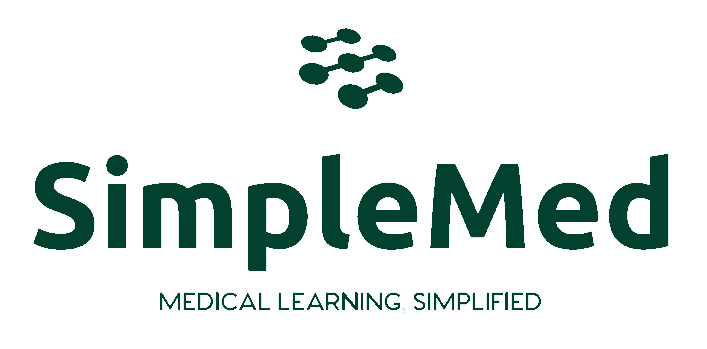Next Lesson - Reticular Formation
Abstract
- The basis of the cerebral cortex works just like a computer; it is made of inputs, processes and outputs.
- Each cerebral hemisphere is split into four lobes: frontal lobe, temporal lobe, parietal lobe and occipital lobe – each of these have many different functions.
- Cerebral dominance is the understanding that some functions in the brain are more represented on one side of the brain than the other.
- The most important areas in the brain to understand and produce language are Broca’s and Wernicke’s areas. Damage to these and other associated structures can cause aphasias.
- The temporal lobe and associated structures such as the hippocampus are crucial for the creation and consolidation of memories in the brain.
- Memory can be split into factual or skill-based.
Core
The cerebral cortex acts as a massive computer, continuously firing neurons and working via a sequence of complex inputs and outputs. The cortex is made up of grey matter, arranged into 6 layers containing cell bodies and dendrites.
- Inputs to the cortex include the thalamus and directly from other areas in the cortex (these can perform actions without any sensory input).
- Outputs are to nerve tracts, which are bundles of axons in the CNS. There are three types of these:
- Association fibres connect nearby regions of the same hemisphere.
- Commissural fibres connect the two hemispheres.
- Projection fibres to the brainstem and cord.
- The inputs connect to the outputs and are processed by interneurons, and the complexity of these connections gives rise to different types of behaviour and emotions.
Localisation of Functions in the Lobes
Each of the cerebral hemispheres are split into four lobes: frontal, temporal, parietal and occipital. Each of these carries a different purpose related to the everyday functioning of the human body.
The frontal lobe is found in the most anterior part of the brain and spans until the central sulcus.
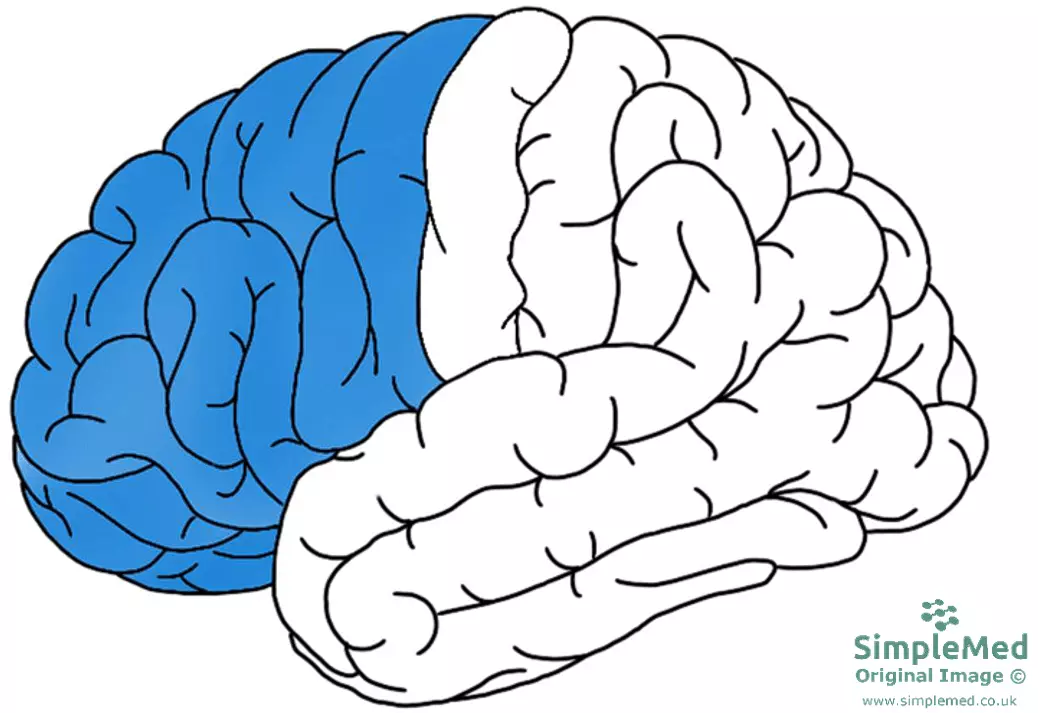
Image - Frontal lobe highlighted
SimpleMed Original by Keertana Anne
It carries functions such as:
- Motor – the primary motor cortex is found in the pre-central gyrus and this sits just anterior to the central sulcus.
- Expressing Speech – Broca’s area is found here, in the left hemisphere for 95% of people.
- Cognition – the prefrontal cortex processes functions such as memory, planning and problem-solving.
- Behavioural Regulation – drinking excess alcohol can lead to frontal lobe dysfunction, leading to inappropriate behaviour.
- Continence – the paracentral lobules are responsible for the control of defecation and urination.
In humans the frontal lobe is the last part of the brain to mature, which is why babies take a lot longer to develop these functions.
These are paired lobes that sit posterior to the frontal lobe, just behind the central sulcus.
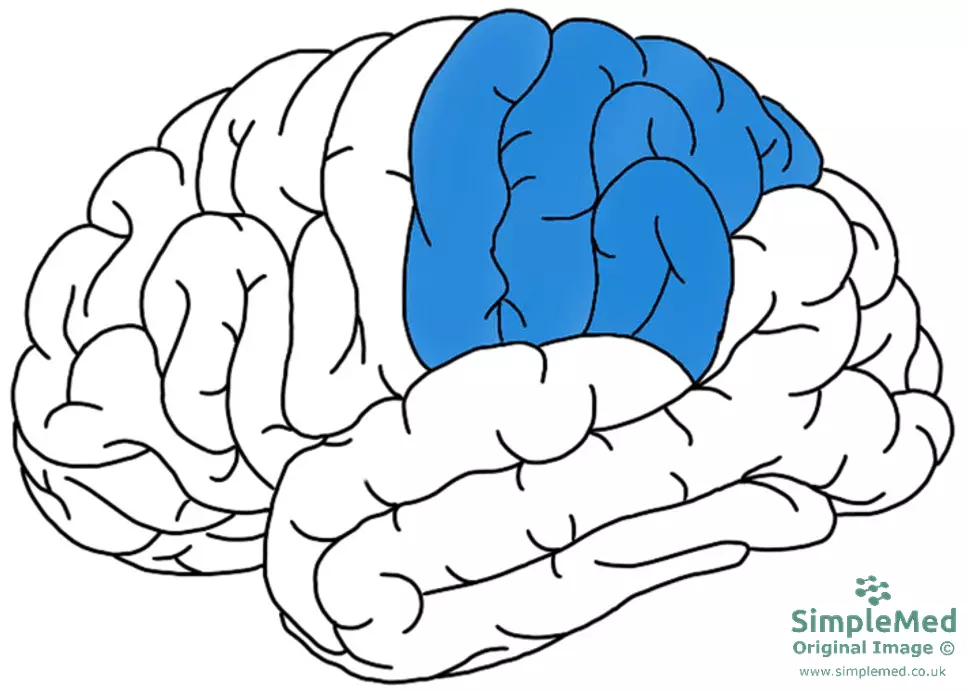
Image - Parietal lobe highlighted
SimpleMed original by Keertana Anne
It carries functions such as:
- Sensation – the post-central gyrus contains the primary sensory cortex and sensory inputs from the skin relay through the thalamus to the parietal lobe.
- Understanding Speech – Wernicke’s area is located here, spanning the junction between the temporal and parietal lobe; similar to Broca’s area this is also usually found in the left hemisphere.
- Awareness of external environment and body. This is another way of the lobe being able to interpret sensory information; it lets you know the location of parts of your body in space.
- Working with the frontal lobe to perform calculation and writing tasks.
These are paired lobes that sit below the parietal lobes on either side. Their main function is to process inputs to be properly comprehended or stored into memory.
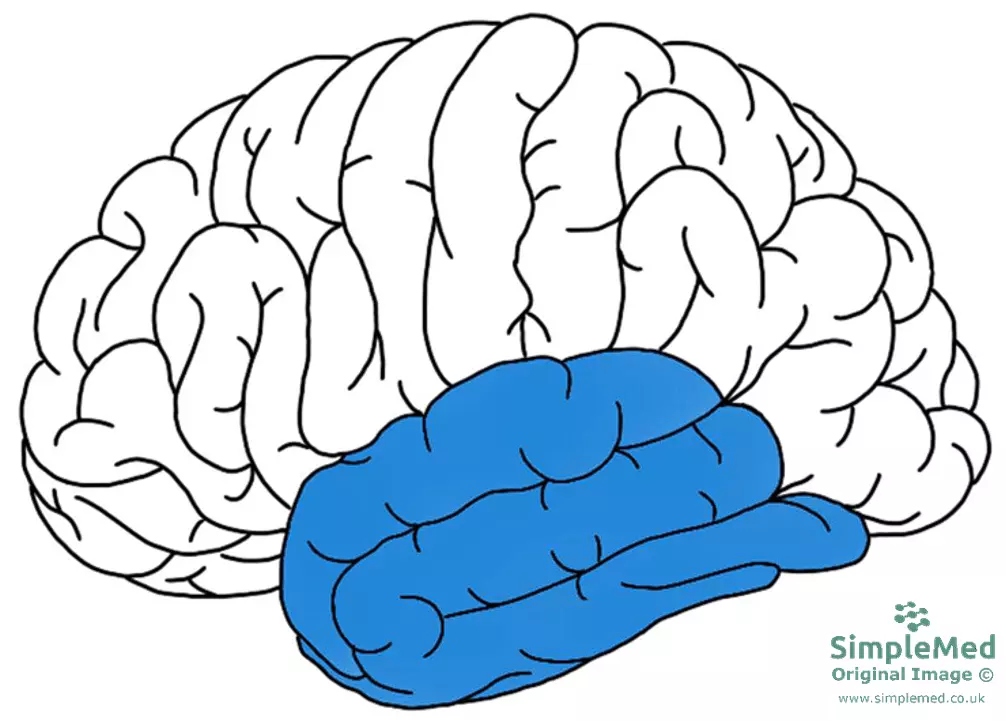
Image - Temporal lobe highlighted
SimpleMed original by Keertana Anne
It carries functions such as:
- Hearing and Olfaction (Smell) – these are controlled by the primary auditory/olfactory cortex respectively in the temporal lobe, meaning damage can cause a lack of these senses, or even auditory/olfactory hallucinations.
- Memory – the hippocampus is a structure associated with the temporal lobe, and this helps to store factual (declarative) information in long-term memory.
- Emotion – the hippocampus and amygdala are structures that have a complex effect on emotion and are thought to be related to psychiatric disorders.
The occipital lobe is located at the most posterior region of the brain, and sits just behind the parietal and temporal lobes. The primary function involves the processing of visual information in the brain.
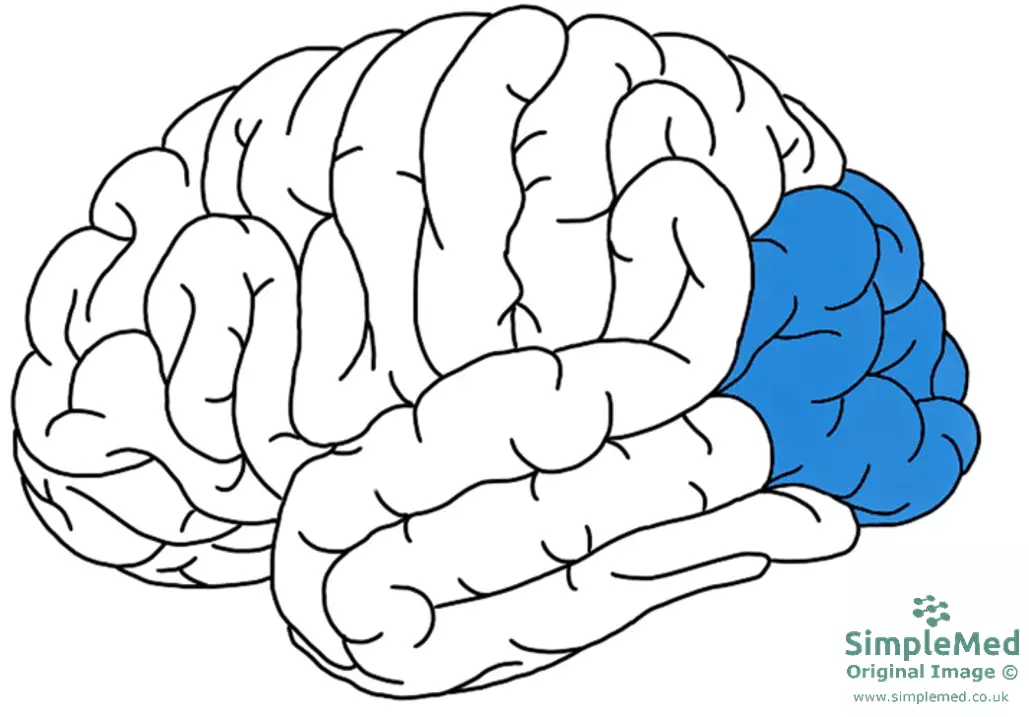
Image - Occipital lobe highlighted
SimpleMed original by Keertana Anne
It carries functions such as:
- Vision – the primary visual cortex sits here and receives information from the eyes via the optic nerves and tracts. See the article on the Visual System for more information. It is able to assess the colour, size, distance and depth of the visualised picture and is also able to scan for any visual stimuli. It transmits the information to other areas of the brain, so they are able to respond appropriately.
Certain functions of the brain are better represented in one hemisphere than the other. Understanding where these functions are more prominently expressed allows the better prediction of the causes of neurological deficits and localising them to an area of the brain.
In 95% of people, the left hemisphere is dominant for language and sequential processing, while the right hemisphere is dominant for visuospatial awareness, emotion and body image. In the remaining 5% of the population, these functions are found on the opposite hemisphere, so the same lesion produces different signs and symptoms.
This is seen specifically in lesions of the parietal lobe, leading to a phenomenon called hemispatial neglect. As the right lobe (in 95% of the population) is specialised for spatial awareness, is it able to process information from both halves of the universe, whereas the left lobe is only able to process from the right half of the universe. Due to this, the right hemisphere is able to compensate for the loss of left hemisphere function, but not vice versa. When lesions of the right parietal lobe occur, patients are noted to have deficits in awareness of the left side of space; this presents as in the image below, with the patient drawing all 12 numbers of a clock on the right side of the clock as the left is ‘neglected’.
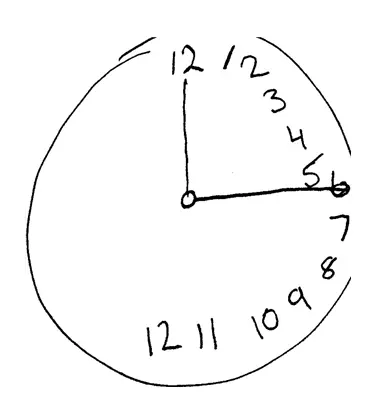
Image - Hemispatial neglect. Patients are asked to draw an image of a clock, but are only able to visualise one-half of the dial
Public Domain Source by Dhru4you [Public domain]
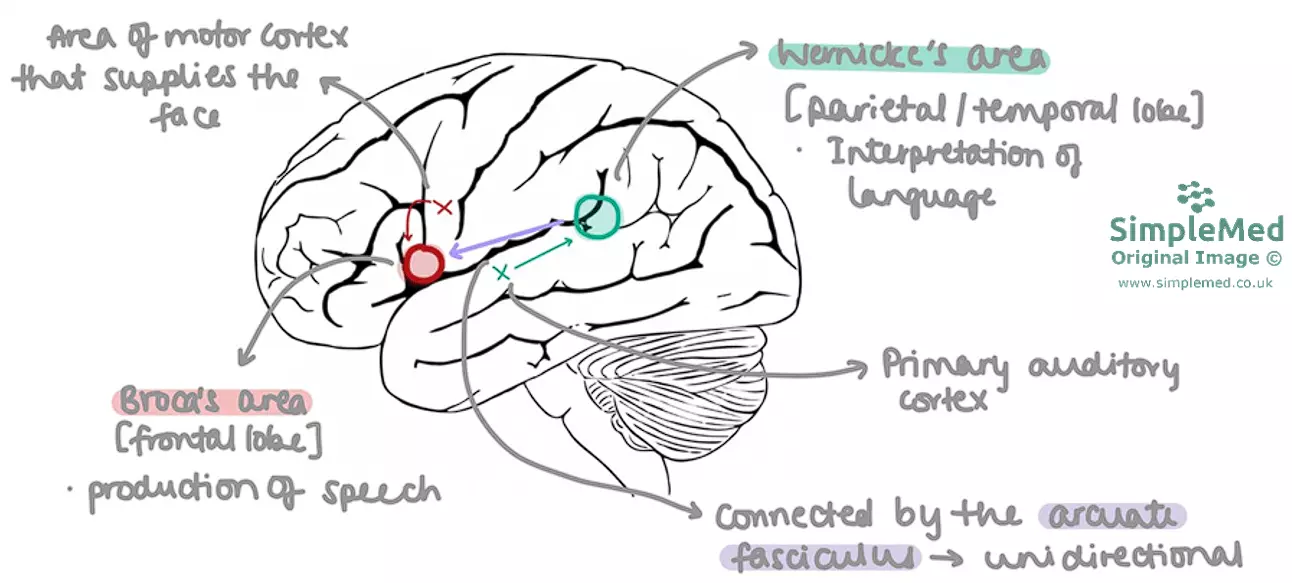
Diagram - This is the pathway for repeating the heard word
SimpleMed original by Keertana Anne
The process of language comprehension and the production of speech takes place in the left hemisphere of the majority of the population. The image above shows the connective pathways between different areas in the brain and how these all work together to produce the spoken word.
The primary auditory cortex (PAC) in the temporal lobe serves to listen to the sounds being transmitted from the ear. Wernicke’s area is found at the parieto-temporal junction in close proximity to the PAC, and it is responsible for decoding and interpreting these sounds. This information is then transmitted along the arcuate fasciculus (a unidirectional white matter pathway that connects the two areas of grey matter) to Broca’s area in the frontal lobe. Broca’s area is responsible for producing speech, and it coordinates with an area of the primary motor cortex that supplies the muscles of both the face, the pharynx and the larynx.
Damage to the individual areas can cause different types of speech deficits. As the left hemisphere is dominant for language processing in 95% of the population, it is usually damage to the left half of the brain that causes these aphasias (or language impairment).
- Wernicke’s Aphasia – arising from damage to Wernicke’s area (parietal/temporal lobe). Patients suffer from receptive aphasia, resulting in fluent speech that is nonsensical. The patient is able to speak normally as Broca’s area is intact, but is unable to understand any inputs.
- Broca’s Aphasia – arising from damage to Broca’s area (frontal lobe). Patients suffer from expressive aphasia, causing staccato speech. The patient understands what is being asked, but struggles to get the words out.
- Conduction Aphasia – arising from damage to the arcuate fasciculus. The patient is able to comprehend auditory inputs and produce fluent speech (although unrelated to the inputs – for example, the answer they give to a question may not make any sense), but they specifically are unable to repeat a heard word.
The following pathways use the same basic areas of the brain (Broca’s and Wernicke’s) in order to produce speech from a variety of inputs.
- Pathway for speaking a thought word
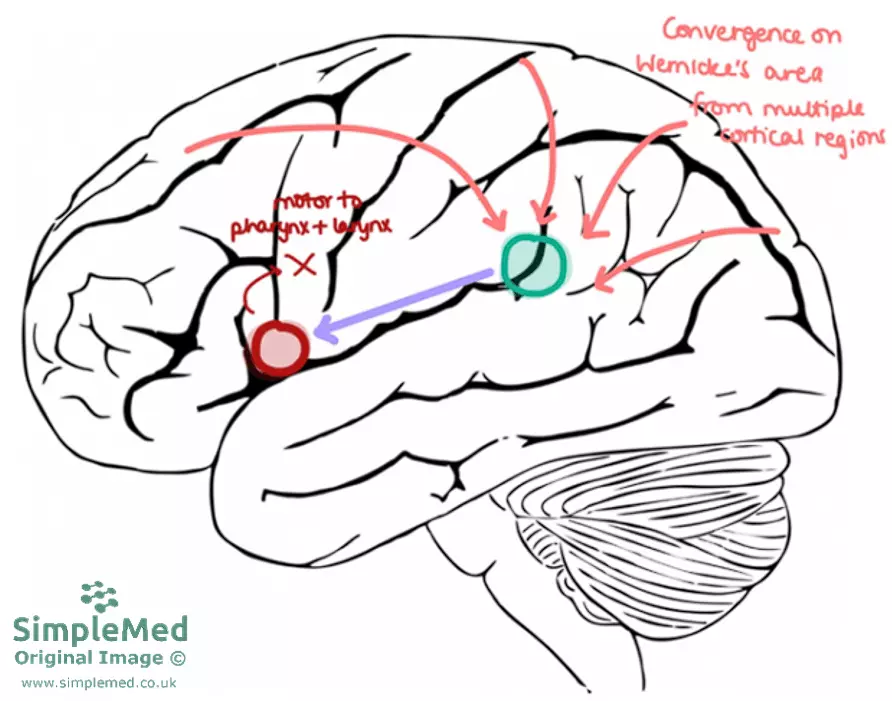
Diagram - Pathway for speaking a thought word
SimpleMed original by Keertana Anne
- Pathway for speaking a written word
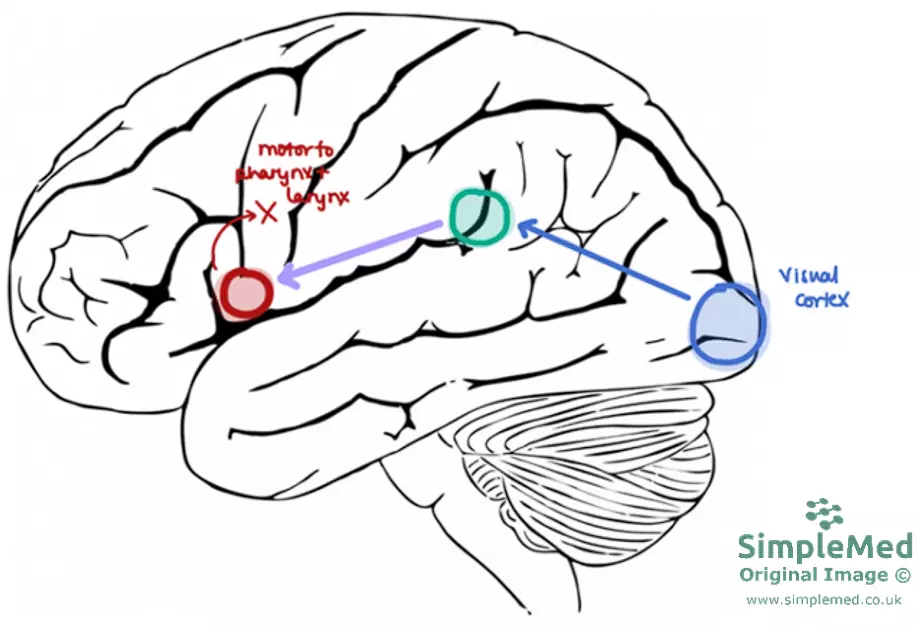
Diagram - Pathway for speaking a written word
SimpleMed original by Keertana Anne
As mentioned above, the temporal lobe and its associated structures are primarily responsible for the creation and consolidation of memories.
Memories are thought to be stored across large areas of the brain and are classified into two different groups: declarative and non-declarative. Declarative (or explicit) memories are factual information and tend to be stored in the cerebral cortex, while non-declarative (or implicit) are learnt skills (such as motor) and emotions are stored in subcortical structures such as the basal ganglia and cerebellum. Declarative memory is the conscious storage and recollection of data, while non-declarative is unconscious.
They are also further subdivided into short-term and long-term memories. Short-term memories can be converted to long-term through the process of consolidation, allowing for declarative or non-declarative memories to be stored in the locations mentioned above. Factors influencing the conversion of these memories include rehearsal, association, and emotional context (for example, post-traumatic stress disorder can cause distressing memories to be stored long-term against the person's will).
The hippocampus (part of the temporal lobe) is essential to consolidate declarative memories into the cerebral cortex. It receives inputs from multiple areas of the brain (visual, auditory, sensory, limbic system etc.), which makes it very good at being able to associate stimuli to a memory.
Learning and memory are attributed to changes in neuronal synapses termed long-term potentiation. Changes in glutamate receptors strengthen the synapses – which are important in learning and memory (See article on Cells and Components of the Nervous System for more information on long-term potentiation).
Edited by: Dr. Maddie Swannack
Reviewed by: Dr. Thomas Burnell
- 2789
